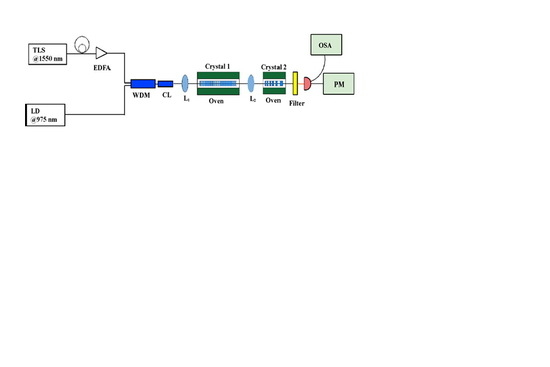A Tunable CW Orange Laser Based on a Cascaded MgO:PPLN Single-Pass Sum-Frequency Generation Module
Abstract
1. Introduction
2. Theoretical Considerations
3. Experimental Setup
4. Results and Discussion
4.1. Power Dependence
4.2. Output Spectra, Tunability, and Beam Stability
5. Conclusions
Acknowledgments
Author Contributions
Conflicts of Interest
References
- Karrer, S.; Bäumler, W.; Abels, C.; Hohenleutner, U.; Landthaler, M.; Szeimies, R.M. Long-pulse dye laser for photodynamic therapy: Investigations In Vitro and In Vivo. Lasers Surg. Med. 1999, 25, 51–59. [Google Scholar] [CrossRef]
- Kapoor, V.; Subach, F.V.; Kozlov, V.G.; Grudinin, A.; Verkhusha, V.V.; Telford, W.G. New lasers for flow cytometry: Filling the gaps. Nat. Methods 2007, 4, 678–679. [Google Scholar] [CrossRef]
- Marzahl, D.-T.; Metz, P.W.; Kränkel, C.; Huber, G. Spectroscopy and laser operation of Sm3+-doped lithium lutetium tetrafluoride (LiLuF4) and strontium hexaaluminate (SrAl12O19). Opt. Express 2015, 23, 21118–21127. [Google Scholar] [CrossRef] [PubMed]
- Chang, W.K.; Chen, Y.H.; Chang, J.W. Pulsed orange generation optimized in a diode-pumped Nd:YVO4 laser using monolithic dual PPLN electro-optic Q switches. Opt. Lett. 2010, 35, 2687–2689. [Google Scholar] [CrossRef] [PubMed]
- Calu, D.J.; Kawa, A.B.; Marchant, N.J.; Navarre, B.M.; Henderson, M.J.; Chen, B.; Yau, H.-J.; Bossert, J.M.; Schoenbaum, G.; Deisseroth, K.; et al. Optogenetic inhibition of dorsal medial prefrontal cortex attenuates stress-induced reinstatement of palatable food seeking in female rats. J. Neurosci. 2013, 33, 214–226. [Google Scholar] [CrossRef] [PubMed]
- Xu, Z.Y.; Bi, Y. Large laser projection displays utilizing all-solid-state RGB lasers. In Light-Emitting Diode Materials and Devices; SPIE Proceedings; John Wiley & Sons Ltd.: Oboken, NJ, USA, 2005; Volume 5632, pp. 115–122. [Google Scholar]
- Fedorova, K.A.; Cataluna, M.A.; Battle, P.R.; Kaleva, C.M.; Krestnikov, I.L.; Livshits, D.A.; Rafailov, E.U. Orange light generation from a PPKTP waveguide end pumped by a cw quantum-dot tunable laser diode. Appl. Phys. B Lasers Opt. 2011, 103, 41–43. [Google Scholar] [CrossRef]
- Li, G.; Chen, Y.; Jiang, H.; Chen, X. Broadband sum-frequency generation using d33 in periodically poled LiNbO3 thin film in the telecommunications band. Opt. Lett. 2017, 42, 939–942. [Google Scholar] [CrossRef] [PubMed]
- Lee, Y.L.; Noh, Y.; Jung, C.; Yu, T.J.; Ko, D.; Lee, J. Broadening of the second-harmonic phase-matching bandwidth in a temperature-gradient-controlled periodically poled Ti: LiNbO3 channel waveguide. Opt. Express 2003, 11, 34–35. [Google Scholar] [CrossRef]
- Fluck, D.; Günter, P. Efficient second-harmonic generation by lens wave-guiding in KNbO3 crystals. Opt. Commun. 1998, 147, 305–308. [Google Scholar] [CrossRef]
- Kumar, S.C.; Samanta, G.K.; Devi, K.; Fotoniques, I.D.C.; Park, M.T. High-efficiency, multicrystal, single-pass, continuous-wave second harmonic generation. Opt. Express 2011, 19, 11152–11169. [Google Scholar] [CrossRef] [PubMed]
- Hansen, A.K.; Andersen, P.E.; Jensen, O.B.; Sumpf, B.; Erbert, G.; Petersen, P.M. Highly efficient single-pass sum frequency generation by cascaded nonlinear crystals. Opt. Lett. 2015, 40, 5526–5529. [Google Scholar] [CrossRef] [PubMed]
- Pan, S.D.; Yu, X.Q.; Yan, Z.; Shen, Y.; Lv, X.J.; Zhu, S.N. Efficient generation of orange light in a quasi-periodically poled LiTaO3 crystal. Appl. Phys. B Lasers Opt. 2008, 93, 749–752. [Google Scholar] [CrossRef]
- Chen, Y.L.; Chen, W.W.; Du, C.E.; Chang, W.K.; Wang, J.L.; Chung, T.Y.; Chen, Y.H. Narrow-line, cw orange light generation in a diode-pumped Nd:YVO4 laser using volume Bragg gratings. Opt. Express 2009, 17, 22578–22585. [Google Scholar] [CrossRef] [PubMed]
- Mieth, S.; Henderson, A.; Halfmann, T. Tunable, continuous-wave optical parametric oscillator with more than 1W output power in the orange visible spectrum. Opt. Express 2014, 22, 11182–11191. [Google Scholar] [CrossRef] [PubMed]
- Gayer, O.; Sacks, Z.; Galun, E.; Arie, A. Temperature and wavelength dependent refractive index equations for MgO-doped congruent and stoichiometric LiNbO3. Appl. Phys. B Lasers Opt. 2008, 91, 343–348. [Google Scholar] [CrossRef]
- Hansen, A.K.; Tawfieq, M.; Jensen, O.B.; Andersen, P.E.; Sumpf, B.; Erbert, G.; Petersen, P.M. Concept for power scaling second harmonic generation using a cascade of nonlinear crystals. Opt. Express 2015, 23, 15921–15934. [Google Scholar] [CrossRef] [PubMed][Green Version]


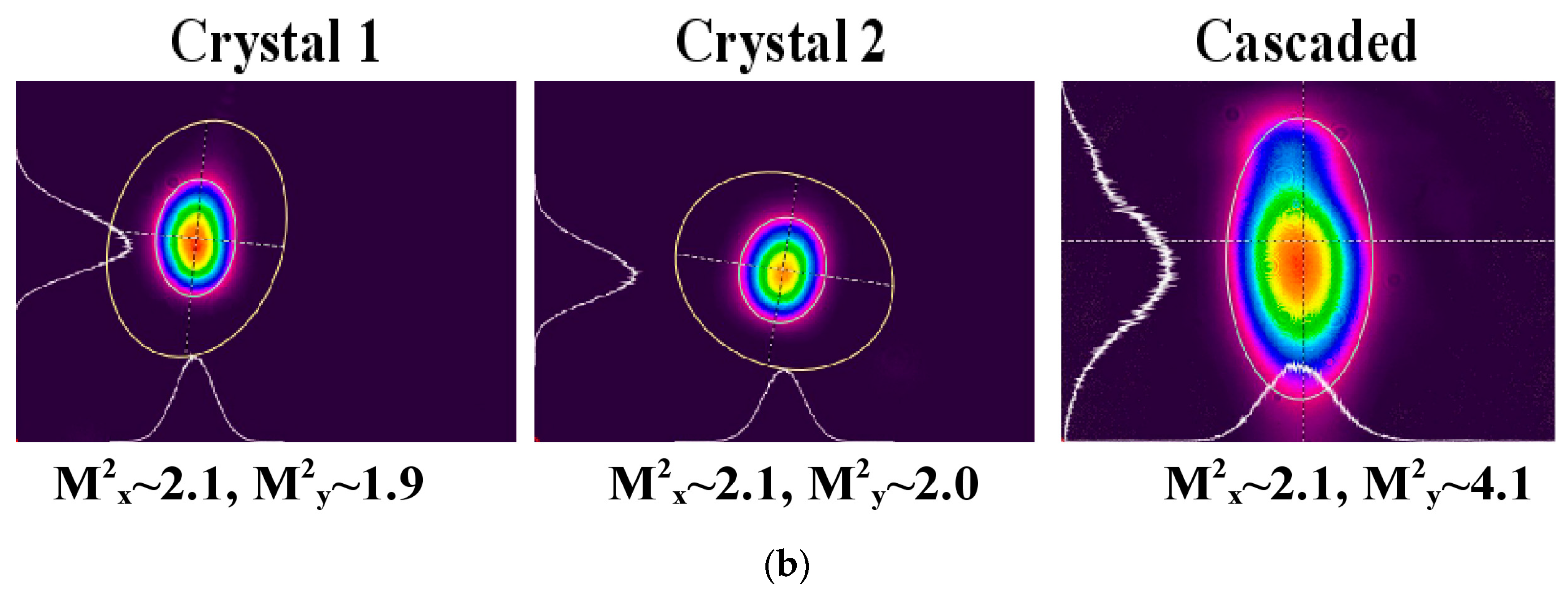
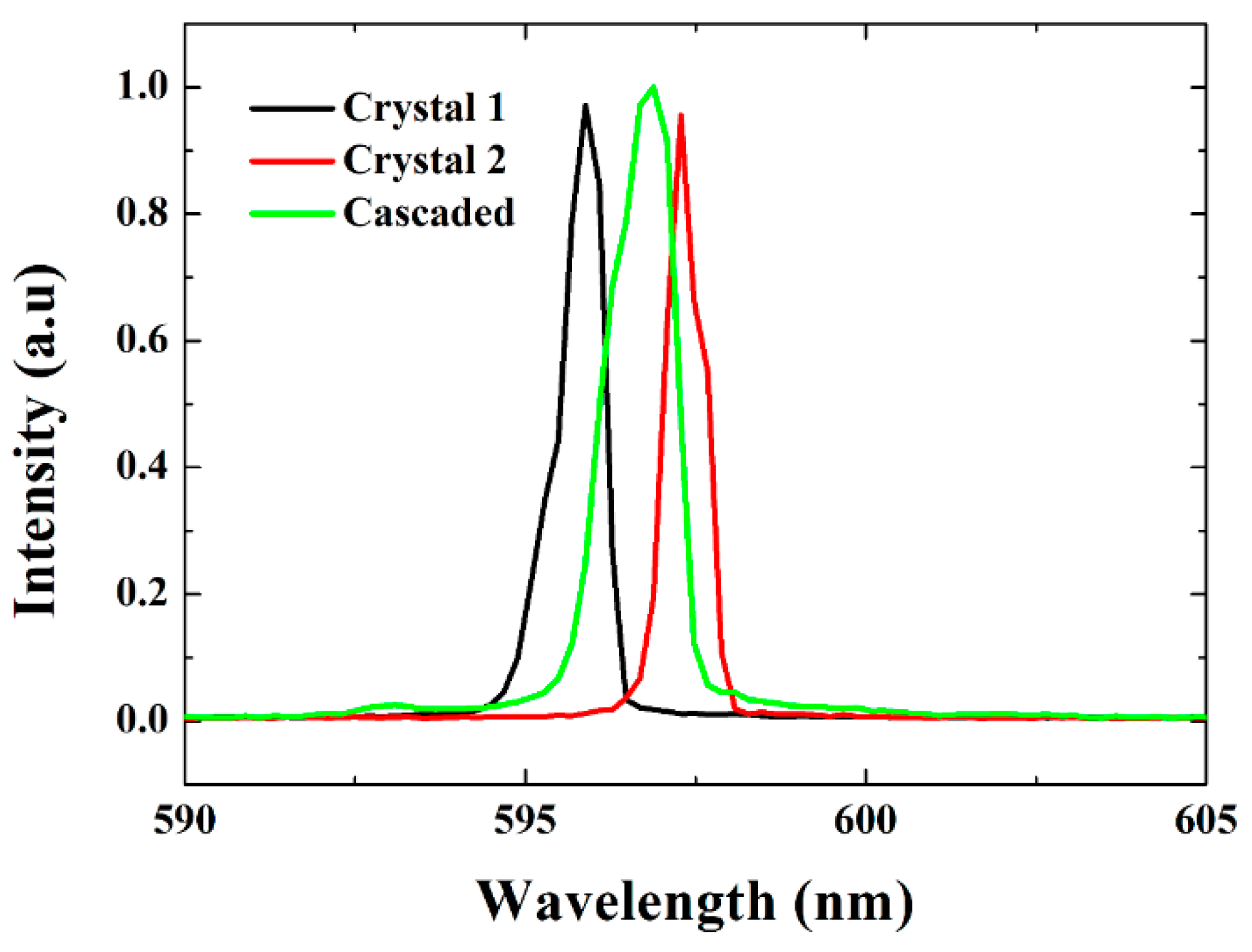
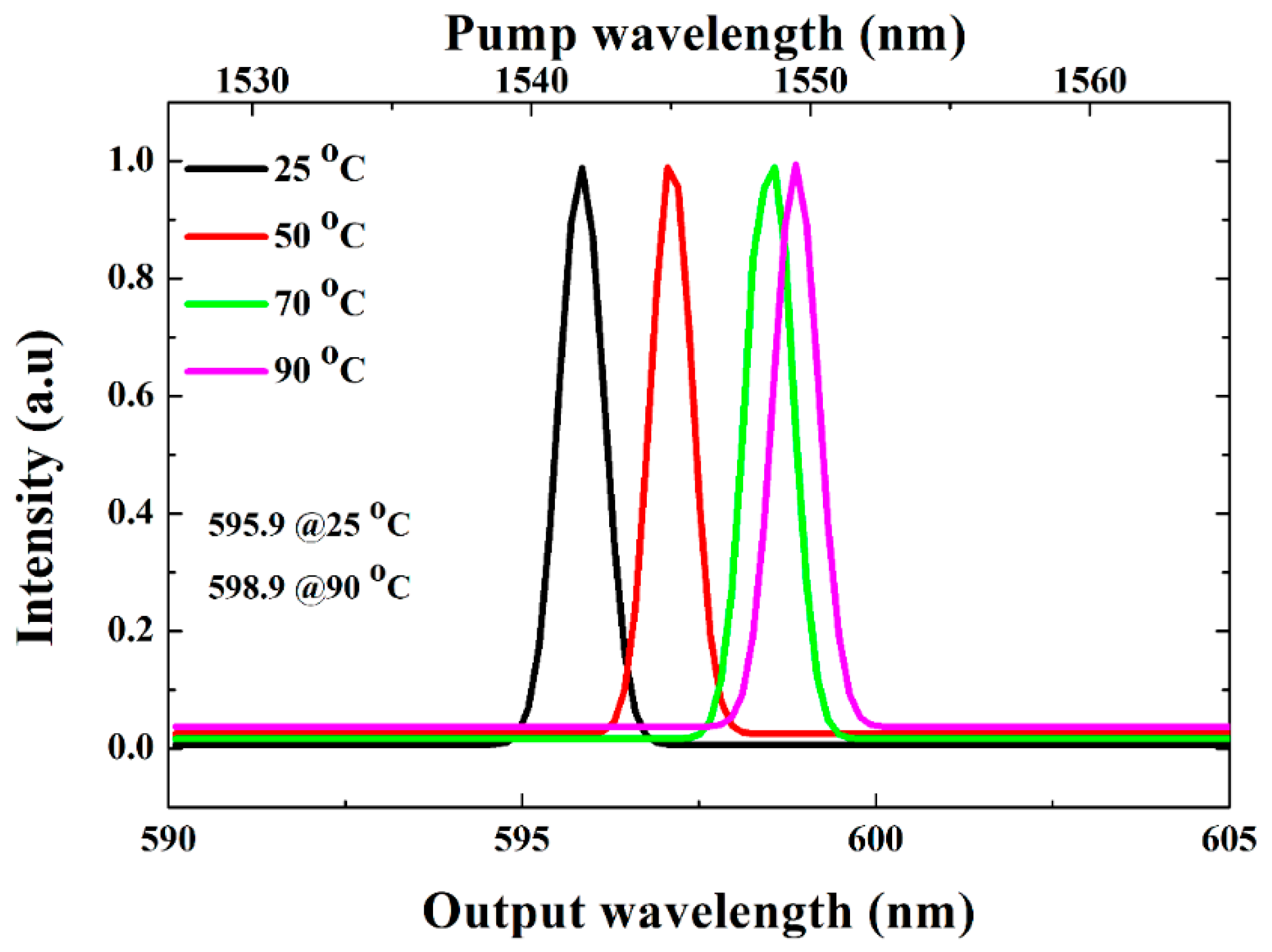
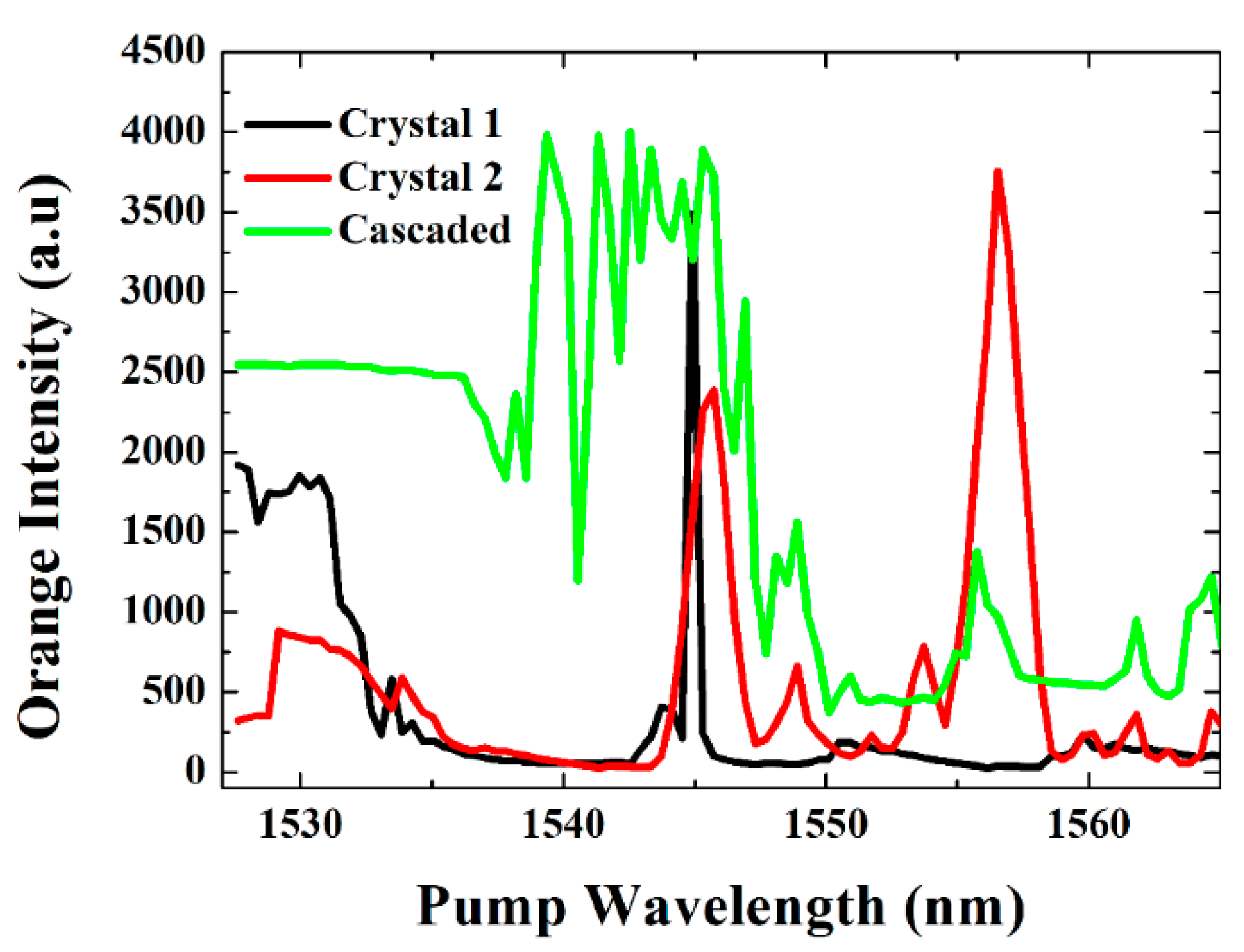
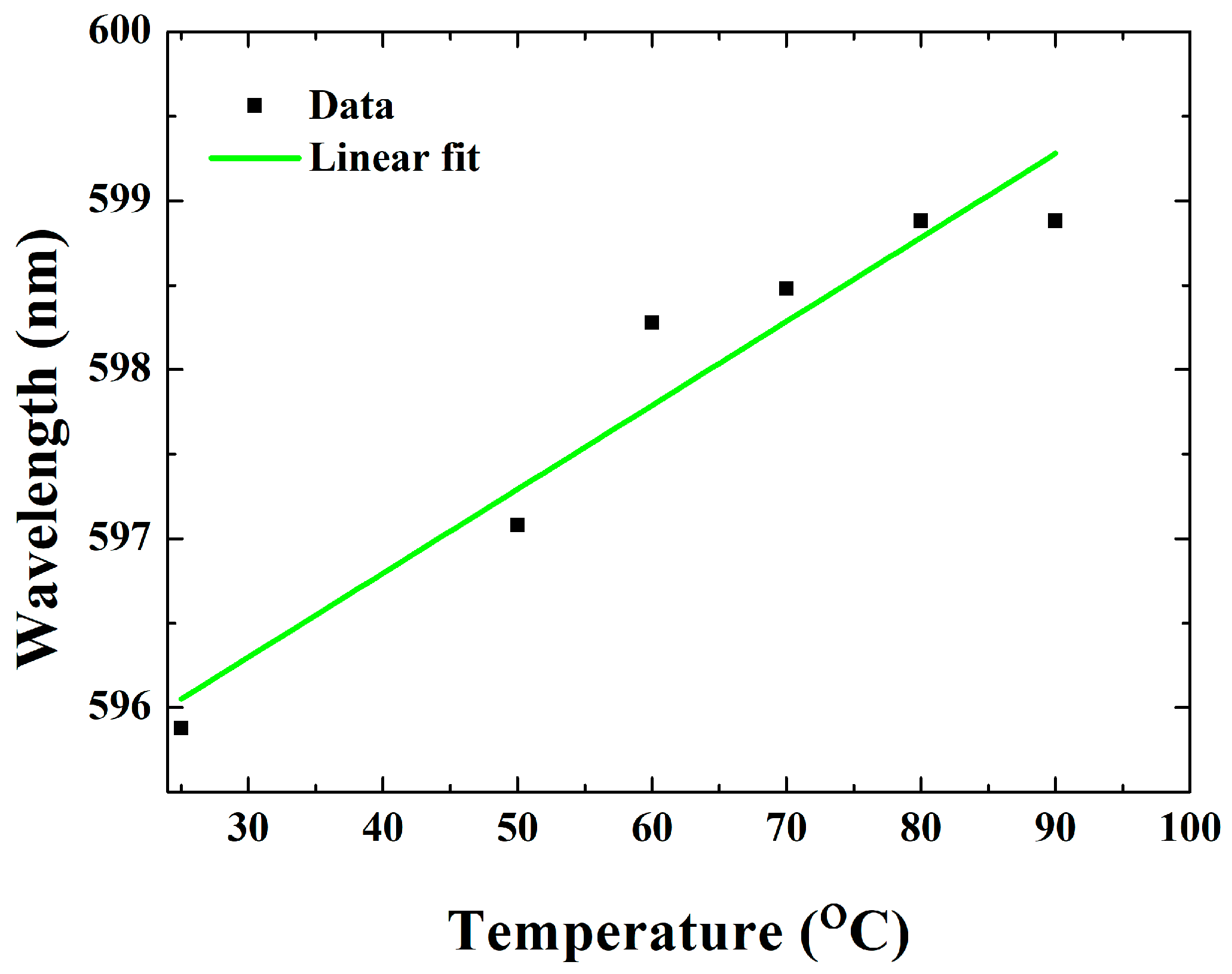
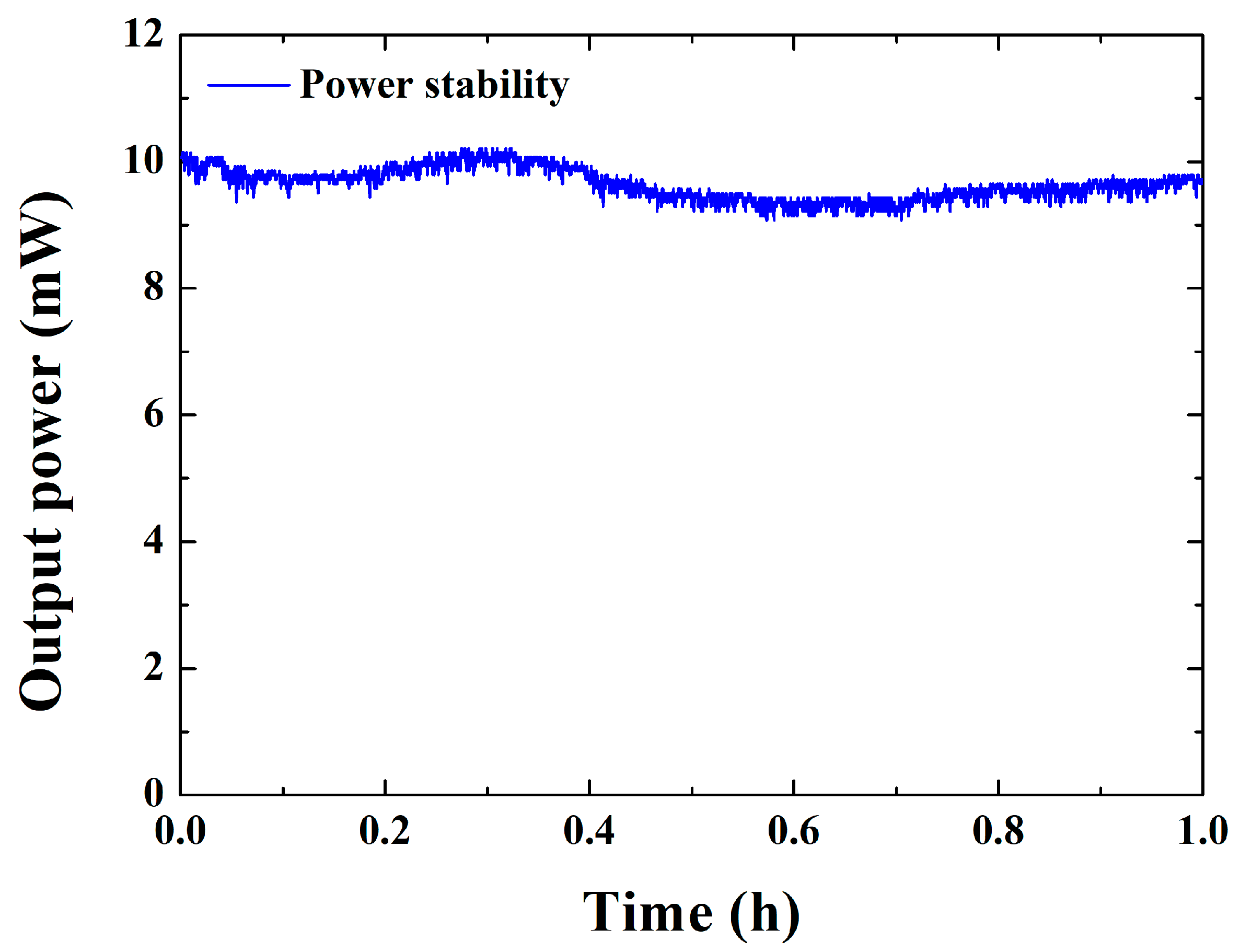
| Crystal | PSFG (mW) | Conversion Efficiency (% W−1) | ||
|---|---|---|---|---|
| Calculated a | Experiment | Calculated b | Experiment | |
| Crystal 1 | 38.2 | 7.1 | 39.9 | 7.4 |
| Crystal 2 | 15.2 | 4.3 | 15.9 | 4.5 |
| Cascaded module | - | 10.0 | 23.4 | 10.4 |
© 2018 by the authors. Licensee MDPI, Basel, Switzerland. This article is an open access article distributed under the terms and conditions of the Creative Commons Attribution (CC BY) license (http://creativecommons.org/licenses/by/4.0/).
Share and Cite
Choge, D.K.; Chen, H.-X.; Tian, B.-L.; Xu, Y.-B.; Li, G.-W.; Liang, W.-G. A Tunable CW Orange Laser Based on a Cascaded MgO:PPLN Single-Pass Sum-Frequency Generation Module. Appl. Sci. 2018, 8, 439. https://doi.org/10.3390/app8030439
Choge DK, Chen H-X, Tian B-L, Xu Y-B, Li G-W, Liang W-G. A Tunable CW Orange Laser Based on a Cascaded MgO:PPLN Single-Pass Sum-Frequency Generation Module. Applied Sciences. 2018; 8(3):439. https://doi.org/10.3390/app8030439
Chicago/Turabian StyleChoge, Dismas K., Huai-Xi Chen, Bao-Lu Tian, Yi-Bin Xu, Guang-Wei Li, and Wan-Guo Liang. 2018. "A Tunable CW Orange Laser Based on a Cascaded MgO:PPLN Single-Pass Sum-Frequency Generation Module" Applied Sciences 8, no. 3: 439. https://doi.org/10.3390/app8030439
APA StyleChoge, D. K., Chen, H.-X., Tian, B.-L., Xu, Y.-B., Li, G.-W., & Liang, W.-G. (2018). A Tunable CW Orange Laser Based on a Cascaded MgO:PPLN Single-Pass Sum-Frequency Generation Module. Applied Sciences, 8(3), 439. https://doi.org/10.3390/app8030439




